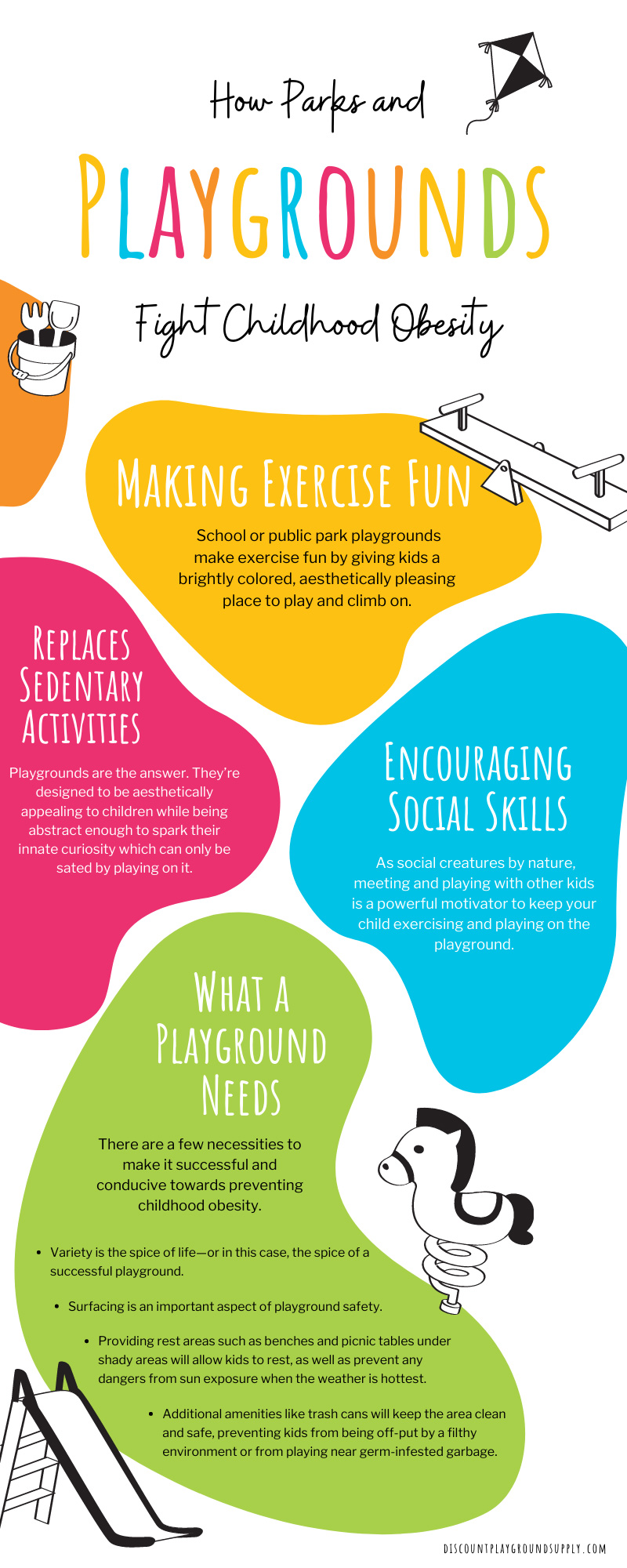Playgrounds are a great opportunity for kids to socialize and burn off the seemingly boundless energy every kid has, which speaks to the testament of how important these public playgrounds really are. However, when faced with the increasingly pressing issue of childhood obesity, playgrounds may also be the answer. Let’s take a look at how parks and playgrounds fight childhood obesity.
Making Exercise Fun
The biggest hurdle, for children and adults, is that exercise is simply boring. For adults, we know how to push through that boredom with the help of music or podcasts, but not children. Kids want something that will keep their attention and allow them to do as they please. Enter the playground. School or public park playgrounds make exercise fun by giving kids a brightly colored, aesthetically pleasing place to play and climb on. Much of the equipment may look like it belongs in a modern art exhibit, but this appeals to the natural curiosity children have about their world and will entice them to go explore how they can manipulate the playground and the world around them.
Furthermore, the inspired appearances of most playgrounds appeal to a child’s imagination. Rather than viewing climbing and running as exercise, kids will instead have the mindset that they’re playing a game. For example, climbing walls are popular amongst kids because they not only want to just see what it’s like to be up so high, but they also get to play pretend with ideas such as climbing a mountain. It may seem simple to fully grown adults, but for kids, that’s all they need to turn exercise into a fun game.
Encouraging Social Skills
In addition to shifting a child’s perception of exercise into something fun, the social component is an added benefit. It’s also crucial in how parks and playgrounds fight childhood obesity. As social creatures by nature, meeting and playing with other kids is a powerful motivator to keep your child exercising and playing on the playground. When kids get together, it’s only a matter of time until they start creating and playing games. Whether these games include traditional team sports or playing pretend, playgrounds serve as the perfect place to play these games. For safety reasons, schools and public playgrounds will always have plenty of space around them to ensure the playground and the kids are highly visible for parents. This typically creates plenty of field space for the more athletic kids to play sports, while the playground set itself serves as the perfect bastion of imagination. Able to take the form of pirate ships or castles, it is a powerful tool for a kid’s imagination that will encourage them to climb over, around, or—if it has tunnels—even through it.
Parents aren’t excluded from a playground’s social aspect, either. Kids love to mimic their parents, since you’re their role model while they learn about the world. So, to get your kid up and moving, taking part in their play will greatly encourage them to perform physical activities; if they see you doing it, they’ll want to be like you.
Replaces Sedentary Activities
One struggle when encouraging your child to get up and exercise through play is that it must compete with your child’s other interests. Activities such as watching television are both sedentary and incredibly effective at capturing a kid’s attention—which is a dangerous combination when it comes to ensuring your child is getting enough exercise and staying at a healthy weight.
Playgrounds are the answer. As we mentioned, they’re designed to be aesthetically appealing to children while being abstract enough to spark their innate curiosity which can only be sated by playing on it. Additionally, kids achieve a sense of greater freedom on playgrounds. While, yes, parents are supervising their kids and will intervene if they see something wrong, the playground is an opportunity for kids to make their own decisions and do as they like without the guidance of an authority figure. This sense of freedom in how to play is a wonderful motivator for your child to pick the playground over watching TV. In turn, they’ll get the exercise they need to stay healthy while also learning new skills such as leadership and decision making to help them develop into more independent individuals.
What a Playground Needs
What makes a good playground, then? If your community or local school is planning on creating a new playground, there are a few necessities to make it successful and conducive towards preventing childhood obesity.
- Variety is the spice of life—or in this case, the spice of a successful playground. Starting off with some of the staples, such as a swing set, is good place to start. They’re staples for a reason, which means kids will expect slides or swings at any playground. Just make sure you’re prepared with maintenance tools such as a swing set hardware kit to ensure your equipment doesn’t fall into disrepair or become a hazard.
- Surfacing is an important aspect of playground safety. While wood chips, pea gravel, or rubber surfacing doesn’t seem much better than grass and dirt, these surfacing materials are valued for their shock absorption rather than how soft they are. This impact resistance will reduce the severity of injuries should a child fall on the playground—and falls will always be the most common source of injury.
- Inevitably, kids will need a break after running themselves ragged under the sun. Providing rest areas such as benches and picnic tables under shady areas will allow kids to rest, as well as prevent any dangers from sun exposure when the weather is hottest. Parents will also be thankful to have a place to sit while they supervise their kids.
- Additional amenities like trash cans will keep the area clean and safe, preventing kids from being off-put by a filthy environment or from playing near germ-infested garbage. Other amenities may be basic sports equipment such as setting up goal posts kids can use to play soccer and other team sports.
When it comes to finding ways for kids to exercise, there is no better option than the playground. They are tailor-made with kids in mind and, when well maintained, are a powerful tool for preventing child obesity.


